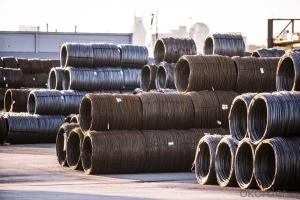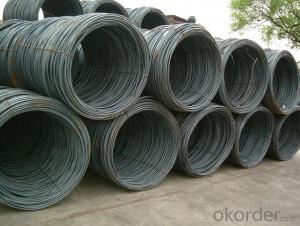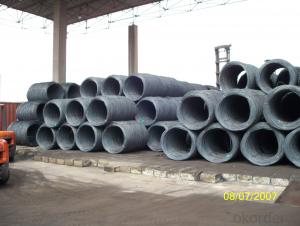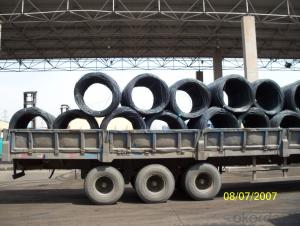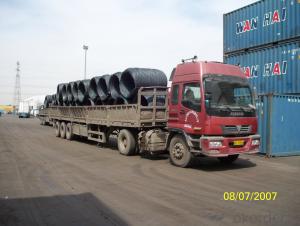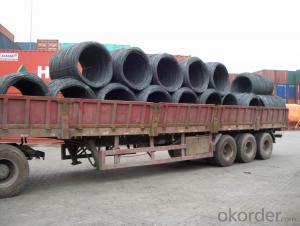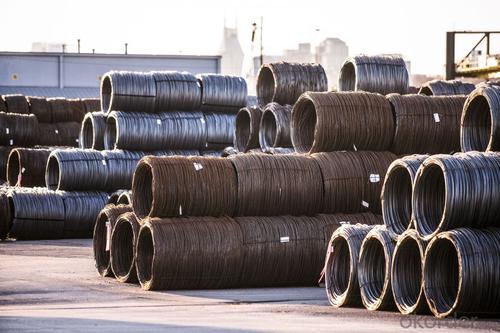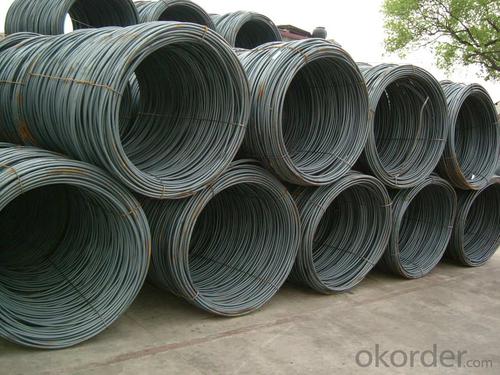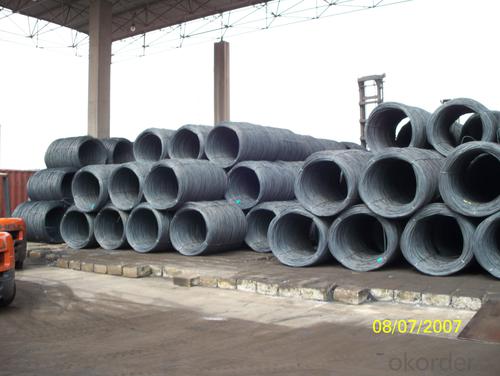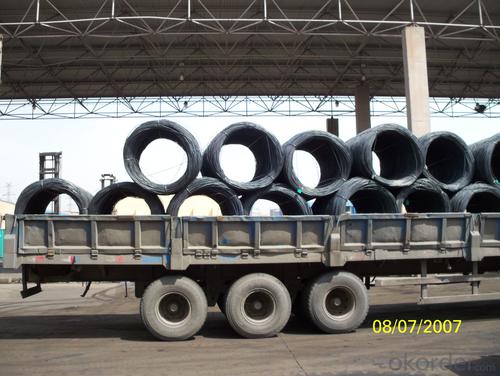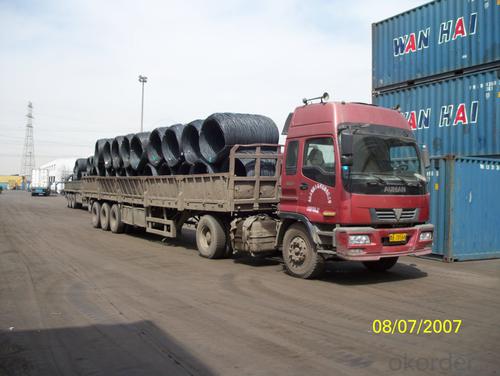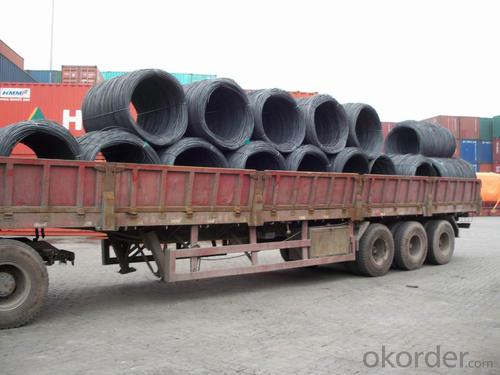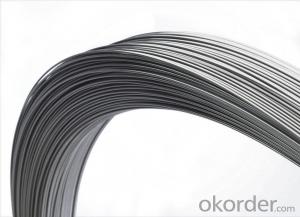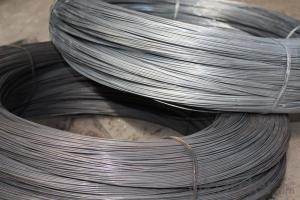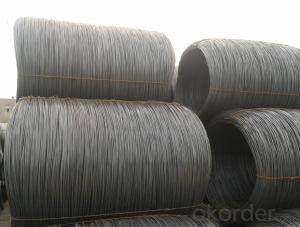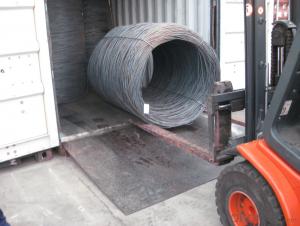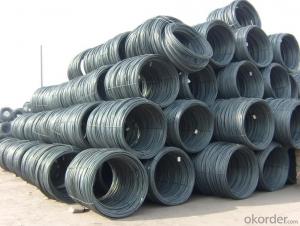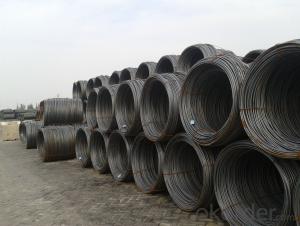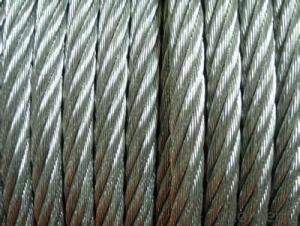SAE1006Cr Carbon Steel Wire Rod 6.5mm for Welding
- Loading Port:
- Shanghai
- Payment Terms:
- TT OR LC
- Min Order Qty:
- 100 m.t
- Supply Capability:
- 30000 m.t/month
OKorder Service Pledge
OKorder Financial Service
You Might Also Like
Specification
Description of SAE1006Cr Carbon Steel Wire Rod 6.5mm for Welding:
OKorder is offering Color Coated Steel Coil Prepainted Steel Coil at great prices with worldwide shipping. Our supplier is a world-class manufacturer of steel, with our products utilized the world over. OKorder annually supplies products to European, North American and Asian markets. We provide quotations within 24 hours of receiving an inquiry and guarantee competitive prices.
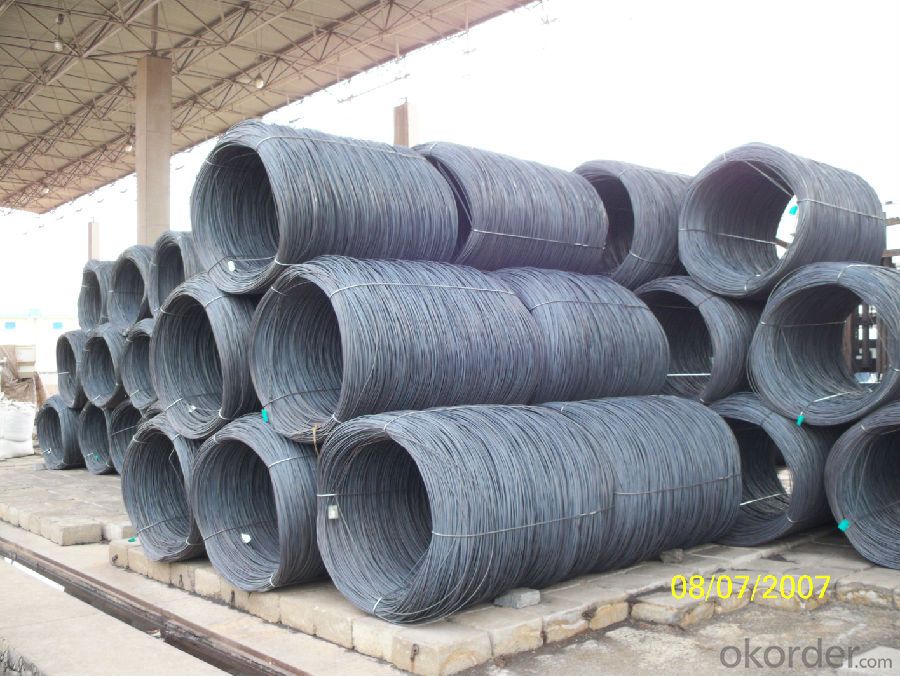
Applications of SAE1006Cr Carbon Steel Wire Rod 6.5mm for Welding:
Color Coated Steel Coil Prepainted Steel Coil are ideal for structural applications and are widely used in the construction of buildings and bridges, and the manufacturing, petrochemical, and transportation industries.
Main Product Features of SAE1006Cr Carbon Steel Wire Rod 6.5mm for Welding:
· Premium quality
· Prompt delivery & seaworthy packing (30 days after receiving deposit)
· Corrosion resistance
· Can be recycled and reused
· Mill test certification
· Professional Service
· Competitive pricing
Specifications of SAE1006Cr Carbon Steel Wire Rod 6.5mm for Welding:
PPGI:
1, Introduction: Color coated steel coils(sheets), i. E. PPGI, also called prepainted steel coils(sheets), are made of galvanized steel coils(sheets) with polymer coatings as surface. It's a new enclosure material and building board with characteristics of light-weighted, heat preserved&insulated, easily installed with bright colors.
2, Production Process: Pretreatment(Degreasing)_Drying_Chromating_Paint Basic Oil_Cooling_Drying_Color Coating_Cooling_Film-covering_Rolling Up
3, Characteristics:
Good at corrosion resistence. Besides zinc coating of the basic plate of galvanized steel sheet, the color coating as the surface has double lifetime to ensure better anticorrosion effect.
With excellent cold bending molded manufacturablity, PPGI products can be processed or directly used as final product. As being light-weighted and conveniently transported, they're widly used to replace wood to save energy.
There're thousands of colors can be chosen as per different application. Any color plays well in decoration.
No pollution with high recycling rate, PPGI coils and sheets are strongly recommended as enviroment-friendly products by the government.
5, eye bands and 4 circumferential bands in steel, galvanized metal fluted rings on inner and outer edges, galvanized.
| commodity | SAE1006Cr Carbon Steel Wire Rod 6.5mm for Welding |
| Techinical Standard: | JIS G3302-1998, EN10142/10137, ASTM A755 |
| grade | Q195,Q215,Q235,SAE1006,SAE1008 SAE1006Cr |
| Types: | Mesh welding |
| Base metal | galvanized, galvalume, cold rolled steel |
| Thickness | 0.14-1.0mm(0.16-0.8mm is the most advantage thickness) |
| Width | 610/724/820/914/1000/1200/1219/1220/1250mm |
| Type of coating: | PE, SMP, PVDF |
| Zinc coating | Z60-150g/m2 or AZ40-100g/m2 |
| Top painting: | 5 mic. Primer + 15 mc. R. M. P. |
| Back painting: | 5-7 mic. EP |
| Color: | According to RAL standard |
| ID coil | 508mm610mm |
| Coil weight: | 2--3MT |
| Package: | Properly packed for ocean freight exportation in 20'containers |
| Application: | Industrial panels, roofing and siding for painting/automobile |
| Price terms | FOB, CFR, CIF |
| Payment terms | 20%TT in advance+80% TT or irrevocable 80%L/C at sight |
| delivery time | 25 days after recepit of 20% TT |
| Remarks | Insurance is all risks |
| MTC 3.1 will be handed on with shipping documents | |
| We accept SGS certificatation test |
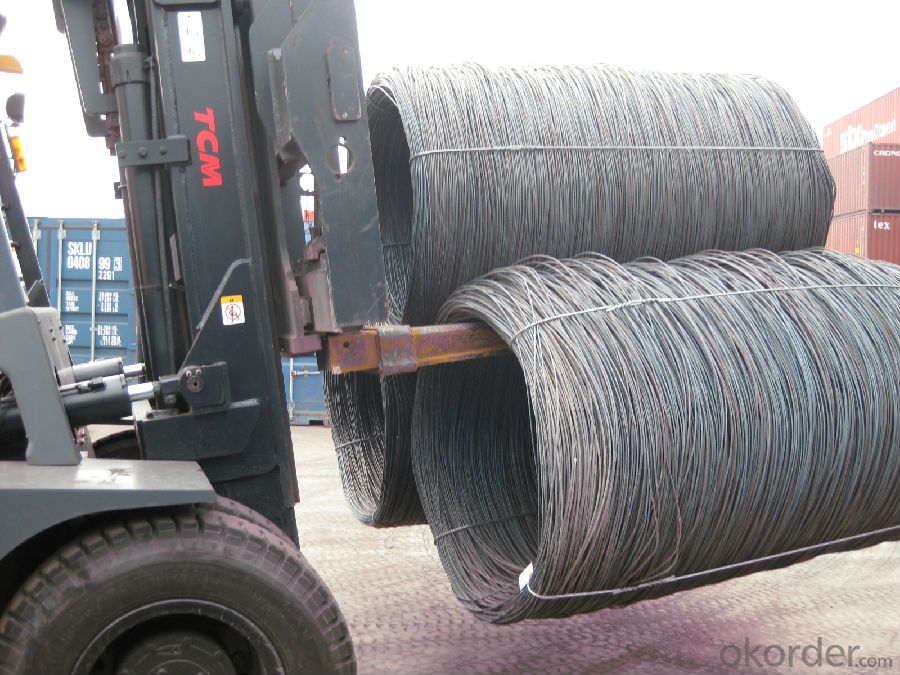
FAQ of SAE1006Cr Carbon Steel Wire Rod 6.5mm for Welding:
Q1: Why buy Materials & Equipment from OKorder.com?
A1: All products offered byOKorder.com are carefully selected from China's most reliable manufacturing enterprises. Through its ISO certifications, OKorder.com adheres to the highest standards and a commitment to supply chain safety and customer satisfaction.
Q2: How do we guarantee the quality of our products?
A2: We have established an advanced quality management system which conducts strict quality tests at every step, from raw materials to the final product. At the same time, we provide extensive follow-up service assurances as required.
Q3: How soon can we receive the product after purchase?
A3: Within three days of placing an order, we will begin production. The specific shipping date is dependent upon international and government factors, but is typically 7 to 10 workdays.
Q4: What makes stainless steel stainless?
A4: Stainless steel must contain at least 10.5 % chromium. It is this element that reacts with the oxygen in the air to form a complex chrome-oxide surface layer that is invisible but strong enough to prevent further oxygen from "staining" (rusting) the surface. Higher levels of chromium and the addition of other alloying elements such as nickel and molybdenum enhance this surface layer and improve the corrosion resistance of the stainless material.
Q5: Can stainless steel rust?
A5: Stainless does not "rust" as you think of regular steel rusting with a red oxide on the surface that flakes off. If you see red rust it is probably due to some iron particles that have contaminated the surface of the stainless steel and it is these iron particles that are rusting. Look at the source of the rusting and see if you can remove it from the surface.
- Q: How is steel wire rod used in the manufacturing of wire forms for electrical connectors?
- Steel wire rod is commonly used in the manufacturing of wire forms for electrical connectors due to its high strength and conductivity properties. It serves as the primary raw material for producing wires of various gauges and diameters, which are then shaped into specific forms required for connectors. These wire forms are crucial components in electrical connectors as they provide secure and reliable connections between different electrical components, ensuring efficient power transmission and signal integrity in various applications.
- Q: What are the different types of wire rods for reinforcement made from steel wire rod?
- There are several different types of wire rods for reinforcement that are made from steel wire rod. These include: 1. Mild Steel Wire Rods: These wire rods are made from low carbon steel and are the most commonly used type of wire rod for reinforcement. They provide good strength and durability, making them suitable for a wide range of applications. 2. High Tensile Steel Wire Rods: These wire rods are made from high carbon steel and are specifically designed to provide greater strength and resistance to tension. They are often used in applications where a higher level of reinforcement is required, such as in construction projects or in the manufacturing of heavy machinery. 3. Stainless Steel Wire Rods: These wire rods are made from stainless steel, which is a highly corrosion-resistant material. They are commonly used in environments where there is a risk of corrosion, such as in coastal areas or in chemical processing plants. 4. Galvanized Steel Wire Rods: These wire rods are coated with a layer of zinc to provide protection against corrosion. They are commonly used in outdoor applications or in areas with high levels of moisture, as the zinc coating helps to prevent rust and deterioration. 5. Copper-Clad Steel Wire Rods: These wire rods are made by cladding a layer of copper onto a steel core. They combine the strength and durability of steel with the excellent electrical conductivity of copper, making them ideal for applications where both properties are required, such as in electrical wiring or grounding systems. Overall, the different types of wire rods for reinforcement made from steel wire rod offer a variety of properties and characteristics to suit different applications and environments.
- Q: What are the common applications of oil quenched and tempered steel wire rod?
- Oil quenched and tempered steel wire rod possesses unique properties that make it suitable for a diverse range of industries. Its applications include: 1. Automotive Industry: The automotive industry extensively utilizes oil quenched and tempered steel wire rod to manufacture various components, including suspension springs, engine valve springs, clutch springs, and transmission gears. The material's high strength and excellent fatigue resistance make it ideal for these demanding applications. 2. Construction Industry: In the construction industry, this type of steel wire rod is widely employed to produce high-strength wire ropes, prestressed concrete wires, and reinforcement bars. Its exceptional strength and durability enable it to withstand heavy loads and extreme conditions in construction projects. 3. Manufacturing Industry: Within the manufacturing sector, this steel wire rod is utilized to produce high-strength fasteners like bolts, nuts, and screws that require resistance to deformation. It is also used in the manufacturing of machinery components, such as gears, shafts, and springs, where toughness and wear resistance are crucial. 4. Oil and Gas Industry: The oil and gas industry extensively relies on oil quenched and tempered steel wire rod for applications like wireline cables, well drilling components, and downhole equipment. The material's high tensile strength and corrosion resistance enable it to endure the harsh conditions encountered in oil and gas exploration and production. 5. Aerospace Industry: The aerospace industry employs this steel wire rod in the production of aircraft cables, landing gear components, and structural parts. Its combination of high strength, fatigue resistance, and light weight make it an ideal choice for these critical applications. In summary, oil quenched and tempered steel wire rod is a versatile material that demonstrates exceptional strength, durability, and resistance to deformation. As a result, it finds applications across a wide range of industries.
- Q: What are the different surface lubrication methods for steel wire rod?
- Some of the different surface lubrication methods for steel wire rod include dry drawing lubrication, oil-based lubrication, soap-based lubrication, and emulsion lubrication. These methods help to reduce friction and facilitate the wire drawing process, ensuring smooth and efficient production.
- Q: How is steel wire rod used in the production of wire for medical devices?
- Steel wire rod is an essential raw material in the production of wire for medical devices. It serves as the starting point for manufacturing wire that meets the specific requirements of medical applications. The steel wire rod is processed through various stages such as drawing, annealing, and coating to achieve the desired diameter, strength, and surface finish. This wire is then used in the fabrication of medical devices like surgical instruments, catheters, and orthopedic implants, ensuring they possess the necessary strength, flexibility, and biocompatibility required for medical use.
- Q: How are steel wire rods used in the production of wire springs for mechanical devices?
- Steel wire rods are used in the production of wire springs for mechanical devices by being shaped and coiled into the desired spring shape. The high tensile strength and durability of steel make it a suitable material for creating springs that can withstand repeated compression and extension. The wire rods are typically heated, drawn through a die to achieve the desired diameter, and then coiled into the specific spring shape. This process ensures that the resulting wire springs can effectively store and release energy, providing the necessary mechanical functionality in various devices.
- Q: What are the main factors affecting the market innovation of steel wire rod?
- The main factors affecting the market innovation of steel wire rod include technological advancements, changes in customer demands and preferences, competitive landscape, government regulations and policies, availability and cost of raw materials, and global economic conditions.
- Q: What are the different types of steel wire rod testing equipment after wire drawing?
- After wire drawing, different types of steel wire rod testing equipment are utilized to guarantee the wire's quality and integrity. Some commonly used testing equipment includes: 1. Tensile Testing Machine: This machine is employed to measure the wire's tensile strength and elongation. It applies a pulling force to the wire and evaluates its resistance and deformation under load. 2. Hardness Tester: This tester is used to determine the wire's hardness. It assesses its resistance to indentation or scratching, which is vital for determining its suitability for different applications. 3. Surface Roughness Tester: This equipment measures the wire's surface roughness. It evaluates the quality of the wire's surface finish, which is crucial in applications where smoothness and aesthetics are significant. 4. Ultrasonic Testing Machine: By utilizing ultrasonic waves, this machine detects defects or inconsistencies within the wire. It identifies cracks, voids, or other imperfections that may affect the wire's performance or structural integrity. 5. Coating Thickness Gauge: To measure the thickness of any applied coating, this gauge is used. It ensures that the wire possesses the necessary coating thickness for corrosion resistance or other protective purposes. 6. Dimensional Measurement Tools: These tools, like micrometers or calipers, are utilized to measure the wire's diameter, roundness, and other dimensional characteristics. They ensure that the wire adheres to the specified specifications and tolerances. 7. Chemical Analysis Equipment: This equipment analyzes the wire's chemical composition. It determines the presence and concentration of different elements, alloys, or impurities, which can impact the wire's mechanical properties and suitability for specific applications. These examples showcase the various types of steel wire rod testing equipment employed after wire drawing. Each equipment type plays a vital role in ensuring the wire's quality, performance, and reliability before it is utilized in various industries and applications.
- Q: How is steel wire rod classified based on its diameter?
- Steel wire rod is classified based on its diameter into different size ranges, commonly referred to as gauges or wire sizes. These sizes can vary depending on the industry or manufacturing standards being followed.
- Q: How is the fatigue resistance of steel wire rod tested?
- The fatigue resistance of steel wire rod is typically tested using a cyclic fatigue test. This involves subjecting the wire rod to repeated loading and unloading cycles until it fails. The number of cycles required to cause failure, as well as any changes in the wire rod's mechanical properties during the test, are measured and analyzed to determine its fatigue resistance.
Send your message to us
SAE1006Cr Carbon Steel Wire Rod 6.5mm for Welding
- Loading Port:
- Shanghai
- Payment Terms:
- TT OR LC
- Min Order Qty:
- 100 m.t
- Supply Capability:
- 30000 m.t/month
OKorder Service Pledge
OKorder Financial Service
Similar products
Hot products
Hot Searches
Related keywords
